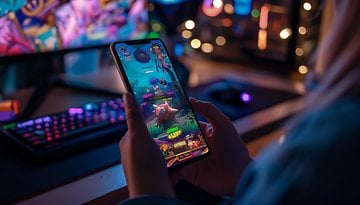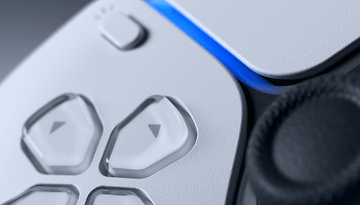My Time at Portia review: Our August Android/iOS game of the month
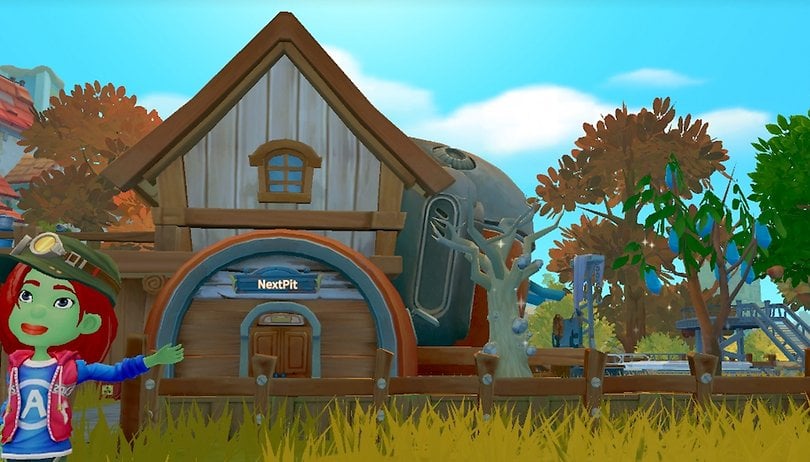

My Time at Portia happened to pick up the gong for mobile game of the month in August after I went through a slew of titles before declaring a clear winner. Originally released on the console and PC, My Time at Portia is also now available on both Android and iOS platforms for $7.99. This is one game that draws heavily from life simulation games such as Animal Crossing and Stardew Valley.
After having neglected it during my recent holidays, I resume my mobile game of the month series in which I present to you a full review of a game on Android and/or iPhone. You can find the first edition of this monthly game review from the narrative title from Arte, which is known by the title, Unmaze.
This review is dedicated to My Time at Portia, a game developed by Pathea, a Chinese independent studio that mixes many genres. Among them include RPGs, life simulations, survival, and management skills. It's a very successful mobile port in my opinion, offering a surprisingly lengthy gameplay for a mobile game as it immerses you fully in a fairly open world, with a gameplay pattern that can quickly become laborious in the literal sense of the word - while you enjoy every single second with it, by the way.
Summary of the game:
- What kind of game is My Time at Portia?
- Story (spoiler-free): Artisan Simulator 2021 in a post-apocalyptic world
- Gameplay: Work is fun (?)
- Graphics: Somewhere between the Wind Waker and Wii Sports
- Conclusion
What kind of game is My Time at Portia?
To sum it all up in a single sentence, I would say that My Time at Portia is a third-person view RPG that is mated to resource management game mechanics set within an open 3D world and is completed by a combat system, platforming and life simulation aspects. This type of game genre can be rather difficult to define since it mixes several elements of various genres with several layers to consider.
You play a created character from scratch (most of the attributes, anyway) that is normally how a classic role-playing game (RPG) works, where you venture in an open world that is presented via a third-person view.
In this open world game, you play the role of a craftsman who has taken over his father's workshop in the fictional town of Portia. This automatically elevates you as one of the official builders hired by the municipality. This is where the second layer of the game comes into play: management. Each construction project that you are assigned to requires specific resources that need to be mined, lumbered, or manufactured. Your character has a life and stamina bar which will deplete as you complete your tasks, and the game has a day/night cycle that will affect your progress.
This brings us to the third layer: the open world concept. Portia's map is quite large and its world is meant to be consistent and immersive at the same time. This means that each NPC (non-player character) around you has his or her own personality, preferences, job, and schedule. Some shops or buildings will close at a certain time, a character whom you want to talk to will not necessarily be at the same place depending on the time in the game.

The penultimate layer of My Time at Portia is the life simulation layer. Your place in the community of Portia and your relationships with its inhabitants evolve. The more contracts you complete, the more your shop's reputation grows and the more rewards you receive for upgrading your equipment and your home. You can become friends with an NPC, ask them out on a date and then become lovers or even get married and have children (and pets).
This brings us to the final layer: the adventure game aspect. The game features a combat system complete with bosses, dungeons, some platforming puzzles, the works. It also tries to reward the player whenever he explores the map, with some resource chests hidden at various places. My Time at Portia also carries a narrative thread, there is indeed a scenario with each chapter that is punctuated by a particularly challenging construction, pushing you to improve your workshop and your equipment.
Story (spoiler-free): Artisan Simulator 2021 in a post-apocalyptic world
Portia is a port city located on the coast of the Western Ocean and a member of the Alliance of Free Cities, a confederation of several city-states formed to protect themselves politically and militarily from the Duvos Empire. But the world of My Time at Portia is far less serious and dangerous than what my description suggested.
The basic plot is this: in your town, you take over the workshop of your father as he has embarked on an adventure in distant lands. So you become the town's "builder", hired by the town council and supervised by the Builders' Guild, around which the entire local economy and industry seems to revolve.
There is also a subplot that unfolds as you progress through the open world that is Portia. Indeed, you will soon learn that Portia was founded on the ruins of an ancient city that was wiped off the map after a "calamity" occurred 330 years earlier. This cataclysm caused a Dark Age that plunged the world into chaos. It was only after 200 years (100 years before your time, that is) that a hero named Peach brought the world out of darkness.
Somewhat similar to Horizon Zero Down after taking all things into consideration, society has regressed technologically into a sort of anachronistic present that ignores almost everything in its glorious past, apart from a few relics comprising of lost machines and AIs that seem to be at the center of a mysterious plot...
I am unable to say more without the risk of revealing any spoilers. Personally, I haven't finished the story yet despite investing 75 hours of my time in the game. The basic pitch is pretty plain, but it's clearly not the key selling point of the game. I do regret that the story crawls at a snail's pace as it remains overshadowed by the long resource gathering and building phases. "Farming" for two days just to unlock a 15-second cinematic? This has frustrated me more than once during my review.
Gameplay: Work is fun (?)
My Time at Portia's gameplay is quite varied on paper, but there is the danger of it becoming very repetitive. As explained earlier (with the multiple layers), we have to distinguish several in-game phases: crafting (or construction) that is done incrementally, life simulation/RPG elements, and combat.
Crafting phases
In My Time at Portia, you will spend 80% of your time going back and forth between the city and your workshop. The main objective throughout the game is to gather resources. Basic resources have been divided into 3 categories: ores, metals, and wood. To obtain ore (copper, iron, bronze, the works!) you will have to go to the mine (where else?). To procure metals, you have to smelt the ore in a furnace, while to get wood, it is a no-brainer that you have to cut down wild trees or go to the tree farm.
Basic resources can also be transformed with the help of machines. This station is a kind of a hub, a platform where you can build everything as long as you have learned the right plan (or diagram).
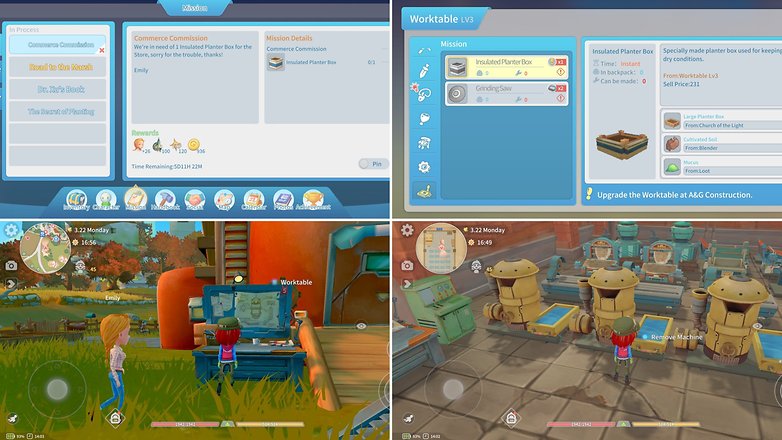
Some construction projects will require specific tools or parts. This means you have to make them on your workbench, again using resources that you have collected previously. Basically, your entire progress hinges on your ability to manage your resources and optimize your production. The game also built-in the idea of money, with the local currency being called Gol, which can then be used to buy clothes, ingredients, tools, furniture, and decorations to further improve your character stats.
Finally, the last resource is your character's stamina. Each strike with a pickaxe to mine or an axe to cut down a tree costs you stamina points. When your bar is empty, you are no longer able to do anything productive. You must then either consume food/drink to restore your stamina or go to sleep. Unlocking certain skills and upgrading certain tools will make your stamina last longer.
Incremental phases
A very important concept in My Time at Portia is time. The game has an hourly, day/night cycle in addition to seasons and weather. Time literally passes in the game so that after my 75 hours of "irl" (in real life) game time, over a year has passed in "My Time at Portia".
This element is very important for two reasons. The first being, your character needs to sleep. After a certain amount of time, normally at 2:30am, you will be forced to stop whatever you are doing and automatically teleported to your bed to sleep before waking up the next morning. This cycle also applies to NPCs, by the way, where each of them have a daily schedule.
But this cycle is also important for your production. Whenever you smelt an ore or cut a piece of wood, it does require in-game time. So the only thing that you have to do is to wait. Talk about an "idle game"!
The word "idle" could be better understood as "inactive". Basically, some elements of the gameplay do not require the player to interact or be proactive. This can be rather frustrating, especially when you're just one piece short of completing a construction project but it takes 5 hours of in-game time to build (or 5 minutes on average in real life).
The RPG and life simulation phases
The first thing that you do when launching My Time at Portia for the very first time is to create your character from head-to-toe, just like in a classic RPG. Your character then has "stats" that you can upgrade by unlocking skill points as you progress.
You can craft and improve your weapons and tools in order to collect more and more resources, and to defeat more and more powerful enemies. It's more of a light-RPG than anything else, as the skill tree isn't very advanced. But that makes it less refined in terms of progress, not to mention having an additional incentive to comply with the routine imposed by the game's direction.
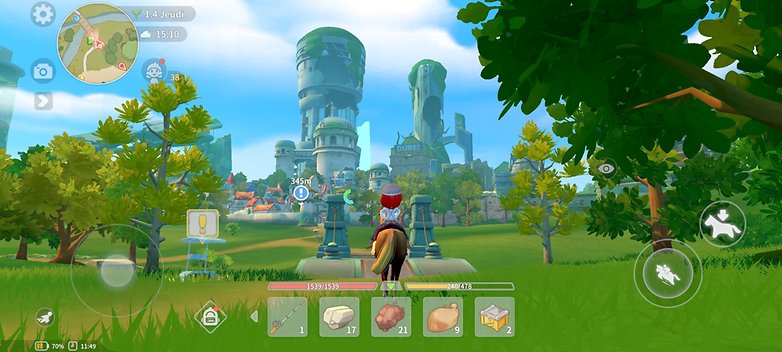
The other component under life simulation, would include social interactions that happen with other inhabitants in Portia. In concrete terms, each time you build or craft something for a character, you will gain relationship points that evolve your social link.
Each character also has a list of interactions that can be made outside of any quest or mission. So at any time you chat with an NPC, give them a gift, play rock, paper and scissors, duel or take a picture together. Such interactions will also earn you relationship points.
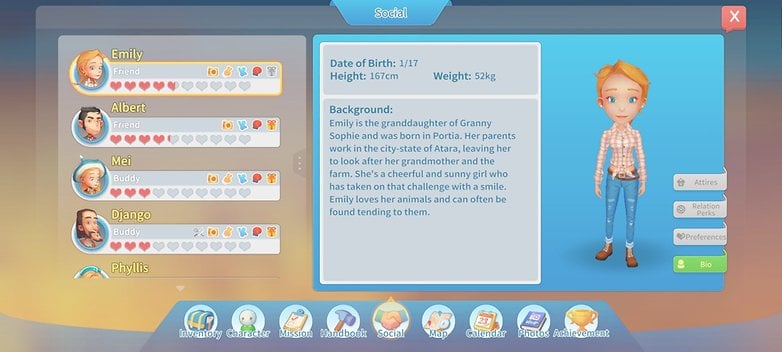
As your relationship progresses, you can go from being a stranger to an acquaintance to a friend, and all the way to a lover. Some characters who have become friends will even show up at your door to ask you out. And when you reach a certain level of relationship with your lover, you can propose to him or her and even have children.
It's a totally corny dimension that doesn't interest me in general, but it's an important aspect in the game. Each character provides you with different benefits depending on your relationship level, for instance. You can even discover a character's preferences for making and giving gifts that will earn you even more relationship points.
Combat
The combat phases do not play the most prominent role in My Time at Portia's gameplay, and that's perhaps not a bad thing after all. You have a fairly limited arsenal that consists of a sword and projectile weapons (which can be unlocked later in the game).
The combat system is ultra simple with a single attack button that you have to furiously click to defeat enemies. Certain types of enemies have different patterns (it becomes easy to figure out their move and attack patterns) which brings a bit of variety, as do the end of level bosses. And you also have a roll button to dodge.
But too often, I found myself just tapping my screen like a moron without ever having to dodge anything. Fighting only happens in the dungeons, although you can encounter enemies in the form of rabid animals when you are in the wild. Honestly, I'm thinking maybe that's just as well. I found the various dungeons to be very forgettable in terms of design and the fights to be downright repetitive. This is clearly the part of the gameplay I enjoyed the least.
Conclusion
As the length of this section shows, the gameplay of My Time at Portia is quite varied on paper. The game mixes a lot of genres and it manages to get you hooked with its well-oiled gameplay patterns. But this work-sleep cycle can also quickly become vicious and I would even say grueling at times with construction projects that take forever and require far too many resources.
The game has this annoying tendency to become a chore, something that is more laborious than entertaining at times. But you can also just walk around and explore Portia's surroundings to 'relax'. I found the open world to be very beautiful, and I felt a real sense of satisfaction when I saw some of my construction projects modernize the city.
Graphics: Somewhere between the Wind Waker and Wii Sports
Visually, My Time at Portia reminded me a lot of Oceanhorn 2, the famous mobile game which also happens to be a carbon copy of The Legend of Zelda: The Wind Waker. The cartoonish graphics and world design mixes fantasy, nature, and fauna, set in a medieval environment amidst a decaying urban surrounding, with historical technologies that give the game a really interesting atmosphere.
The city of Portia seems to be alive with buildings with its modeled interiors, changing landscapes that correspond with the seasons and weather conditions, just like its characters who live their lives and whose habits you have come to be familiar with. Well, they're not that well-modeled and do resemble more like Nintendo's Mii characters than the official visuals that the game suggests.
There are also stability issues in the game, especially when you move from one area into another, such as from outside a building to inside and vice versa, where the framerate might suffer slightly. But I don't feel that the technical issues were as serious as I've read in other reviews.
For my review, I played My Time at Portia on a OnePlus Nord 2 that is powered by the MediaTek Dimensity 1200 SoC which is mated to 12GB of RAM. I ran the game with the graphics in "high" at 60 FPS. I do think that on a mid-range smartphone, you'll have to lower your graphics settings though. I would say, for comparison's sake, that My Time at Portia is at least as resource intensive as a game like Genshin Impact.
Overall, I found the game to be visually compelling. It's not realistic, but that's not its goal. The recipe isn't the most original either, but for a game of this scope and size on a smartphone, I found the experience to be more than satisfactory.
Combined with the consistency, or rather the dynamism, of the open world that changes and evolves before your very eyes as you progress, Portia is a nice place to lose yourself in a bit. However, don't do so for too long, either, because there are iron bars to melt and wooden boards to cut down that are constantly waiting for you!
Conclusion
Is My Time at Portia worth the admission price of $7.99 on the Google Play Store and the Apple App Store?
In terms of longevity, I'd say yes. It's very, very rare for a mobile game - and a single player game at that - to offer a story that lasts for over 10 hours. Admittedly, the lifespan is "artificially" extended by the crafting system that prevents progress until you complete a certain construction project. But there are some people like me, who really enjoy this laborious side of farming and grinding, and love to complete all of the side quests instead of diving straight into the main quest.
Speaking about the negative aspect of such gameplay, you will be easily frustrated if you are more interested in the story development or action of a game as My Time at Portia is not the most engaging in both departments. I would even without any exaggeration that you will risk burning out! I was sometimes seriously cheesed off by the waiting time during the crafting phases.
Add to that the game's overall pace and time cycle, and it really feels like work. This is both a good way to get players hooked onto the game, especially completionists like me who want to finish everything from the beginning to the end. However, it is also an approach that will discourage more casual players in my opinion.
I would also like to point out that you can really optimize or even automate your production once you have gone beyond half the game. There are some mechanics that will "relieve" you from the repetitive boredom that you had to endure at the beginning. In my opinion, this game is well worth checking out.
I can count using the fingers of my one hand the number of smartphone games released over the years that offer such a vast open world and a long gameplay time. My Time at Portia is a very good port and an excellent game, as long as you don't make a business out of it.
